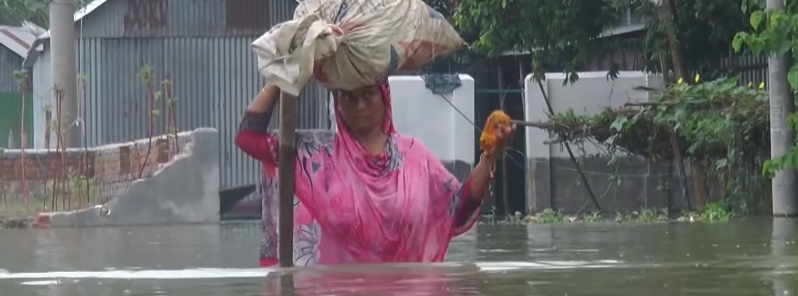More than 1 million people flee as second wave of flooding hits Bangladesh, 7 million already affected

More than 1 million residents have fled their homes as the second wave of severe flooding hit wide swaths of Bangladesh, officials said Tuesday, July 14, 2020. As many as seven million people are already affected, with water levels at major rivers rising at about two dozen points in 20 districts.
"The situation is worsening," said Arifuzzman Bhuiyan, an executive engineer with the Bangladesh Water Development Board (BWDB). "The worst thing is that the floods are getting prolonged this year, which is a bad sign."
More than one million villagers are marooned or leaving their homes, along with their belongings and even with their cattle. Over the last 24 hours, many new areas in the northern, northeastern, and central regions have been affected, Bhuiyan added.
In the Kurigram District, one of the worst affected areas, thousands of residents have left their homes to move to higher grounds since the weekend, said Mizanur Rahman Soikat, project coordinator with the Bidyanondo Foundation. The charity has been providing food to affected villagers, many of whom have lost their livelihood.
Some 135 000 Kurigram citizens have been given food assistance over the past few weeks, Soikat said, along with further help from the government.
Nearly one-third of Bangladesh is underwater after historic monsoons floods. Almost four million people are affected by the heavy rains that are overflowing the river systems. #flooding #Bangladesh pic.twitter.com/jHubxZkhme
— CGTN America (@cgtnamerica) July 14, 2020
A.T.M. Akhteruzzman, a relief and rehabilitation officer in the northern district of Rangpur, said about 50 000 residents along the Teesta River have fled so far.
BWDB issued a red alert in the area on Monday, July 13, as the river was already flowing more than 0.5 m (1.7 feet) above the danger level.
The latest fatality was an eight-month-old baby who drowned in floodwaters. Atiar Rahman, chairman of Gaddimari Union Parishad in Lalmonirhat said the mother found her baby's body floating in the floodwater that infiltrated their home near Teesta.
According to the Indo-Asian News Service (IANS), as many as seven million people have already been affected.
Heavy downpour and rushing waters from upstream India are the major reasons for flooding in Bangladesh, which usually receives monsoon rains between June and October. These triggered the second wave of flooding, while the first wave has not yet even receded.
Flood submerged thousands village home, market and road of Kalmakanda upazila, Netrakona district.
Flood situation in #Bangladesh is worsening in every hours. People need emergency food supports and shelter. pic.twitter.com/gXDF4kBesn
— Ershad Khan (@ershadkhandu) July 13, 2020
Floods started in late June and have continued to worsen ever since, affecting many new areas and destroying crops, affecting millions of people, particularly in impoverished regions.
"Waters are coming from India, while heavy rainfalls in the region are causing havoc," said Akhteruzzman.
"We are trying to do our best to stand by the people, as we have already provided more than 300 tons of rice, cattle food, baby food, and a good amount of cash. Our relief operations will continue."
The government has opened 975 flood shelters and mobilized 175 medical teams.
Heavy monsoon rains are forecast throughout the country in the following days, which could further worsen the already grim situation.
Featured image credit: SOMOY TV/YouTube

Commenting rules and guidelines
We value the thoughts and opinions of our readers and welcome healthy discussions on our website. In order to maintain a respectful and positive community, we ask that all commenters follow these rules.